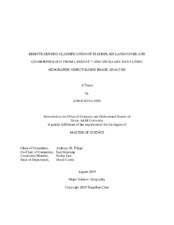| dc.description.abstract | Detailed classification of floodplain land cover and geomorphology is a fundamental step in understanding the process-pattern interactions between a river channel and its floodplain. Although supervised classification has been used extensively to classify remote-sensing images for a range of landscapes, including floodplain landscapes, GEOgraphic Object-Based Image Analysis (GEOBIA) has been rarely used to classify vegetation and the geomorphology of these environments. In this study, using GEOBIA, we examine the floodplain of Río Beni, located in the Bolivian Amazon. Río Beni is a highly-dynamic river system, characterized by rapid planform migration and chute and neck cut-off processes that are observable over decadal scales. The Río Beni floodplain is abundant with geomorphic landforms of varying types, ranging from oxbow lakes, meander scars, to scroll bars. The floodplain vegetation is composed of forest and non-forest vegetation, entailing spatially-varying patterns across the floodplain. In order to determine the effects of varying input data on remote sensing-based land-cover and geomorphic classification within the Río Beni floodplain, we perform 24 dataset-combination classification trials, where Landsat 7 ETM+ image bands are combined with various ancillary data layers as joint inputs, including the enhanced vegetation index (EVI), normalized water index (NDWI), and a detrended digital elevation model (DDEM). Overall classification accuracy for the dataset-combination trials range from 55.22% to 88.52%, whereas the Kappa Index of Agreement ranges from 0.4417 to 0.8539.
The highest classification accuracies for each respective land-cover and geomorphic class—stemming from the various dataset-combination trials—are: river (91.32%), oxbow lake (96.90%), sandbar (86.68%), scroll bar ridge (28.85%), scroll bar swale (35.53%), forest (97.01%), non-forest vegetation (80.29%), and bare soil (96.39%). Results also indicate that in addition to the Landsat 7 image, the NDWI image is beneficial to the classification of the river class; the EVI and NDWI images are beneficial to classifying oxbow lake and non-forest vegetation classes; the DDEM aids in the classification of the sandbar class; and the DDEM and NDWI data layers are beneficial to classifying bare soil. Nine automated local threshold methods (Bernsen, Contrast, Mean, Median, MidGrey, Niblack, Otsu, Phansalkar) were also applied to two scroll bar rich areas within our floodplain study site to segment image into scroll bar ridges and scroll bar swales. Result showing Bernsen’s method with a local radius 210m can achieve an accuracy of 92.20% across our two study sites. When applying to the whole floodplain, the mean method can achieve an accuracy of 81.02%. | en |


